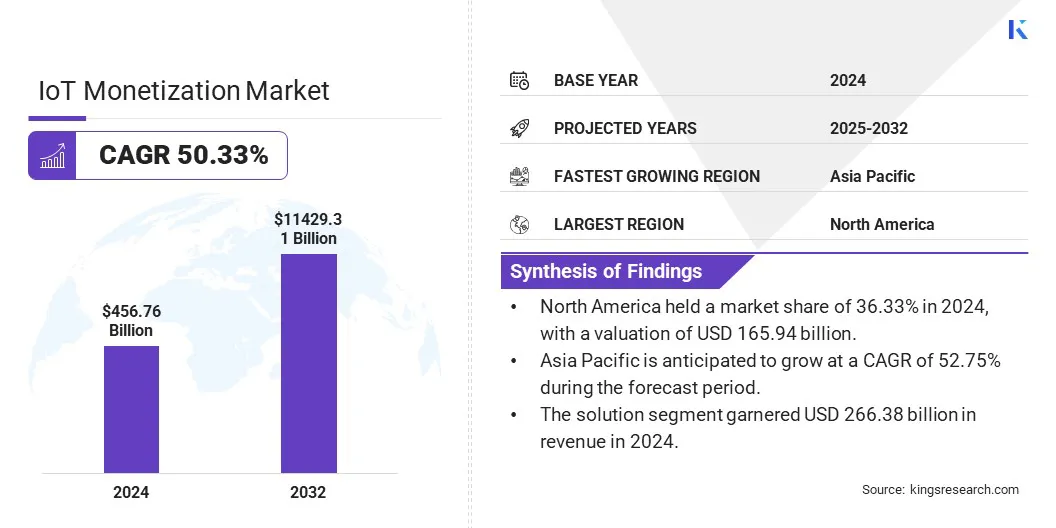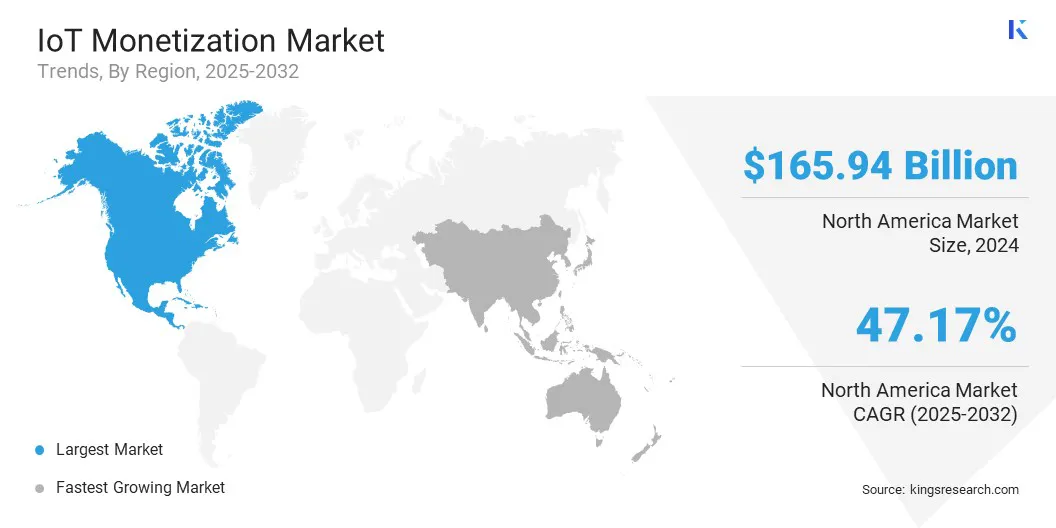Market Definition
The market refers to the industry focused on generating revenue from Internet of Things technologies by offering devices, data services, and platforms. It includes applications across manufacturing, healthcare, retail, and transportation.
This market involves various business models such as subscriptions, pay-per-use, and data analytics. The report outlines the primary drivers of market growth, along with an in-depth analysis of emerging trends and evolving regulatory frameworks shaping the industry.
IoT Monetization Market Overview
The global IoT monetization market size was valued at USD 456.76 billion in 2024 and is projected to grow from USD 658.86 billion in 2025 to USD 11,429.31 billion by 2032, exhibiting a CAGR of 50.33% during the forecast period.
Market growth is being driven by the expansion of 5G networks and the integration of IoT with cloud platforms. These advancements enable real-time communication, scalable infrastructure, and efficient data handling.
Major companies operating in the IoT monetization industry are PTC, IBM, Intel Corporation, Microsoft, SAP, Siemens, Oracle, Amazon Web Services, Inc., Robert Bosch GmbH, Qualcomm Technologies, Inc., SoluLab, Verizon, Arm Limited, Honeywell International Inc., and Huawei Technologies Co., Ltd.
The market is gaining traction due to the growing adoption of predictive maintenance solutions. IoT-enabled sensors facilitate real-time machinery monitoring, allowing for the early identification of potential failures and the implementation of scheduled maintenance.
This minimizes unplanned downtime, reduces repair costs, and extends equipment lifespan. In manufacturing environments, predictive maintenance enhances production efficiency and operational reliability. Additionally, it creates monetization opportunities through value-added service offerings, supporting cost optimization and improved financial performance.
- In January 2025, AT&T Business introduced the Connected Spaces Smart IoT Sensor Kit, designed for small and medium-sized businesses. This plug-and-play solution offers affordable, scalable sensors for monitoring various factors like leaks, temperature, humidity, and motion. The kit helps businesses optimize resources, enhance operations, and improve customer satisfaction by providing real-time data and insights, ensuring efficient management without disrupting daily activities.

Key Highlights:
- The IoT Monetization market size was recorded at USD 456.76 billion in 2024.
- The market is projected to grow at a CAGR of 50.33% from 2025 to 2032.
- North America held a market share of 36.33% in 2024, with a valuation of USD 165.94 billion.
- The solution segment garnered USD 266.38 billion in revenue in 2024.
- The large enterprises segment is expected to reach USD 6,134.87 billion by 2032.
- The healthcare segment is anticipated to witness the fastest CAGR of 53.80% during the forecast period.
- Asia Pacific is anticipated to grow at a CAGR of 52.75% during the forecast period.
Market Driver
Expansion of 5G Networks
The market is driven by the expansion of 5G networks by enabling high-speed, low-latency communication and supporting large-scale device connectivity. It allows real-time data exchange, dynamic Quality of Service (QoS), and precise location tracking, critical for sectors like manufacturing, logistics, and healthcare.
Through capabilities like network slicing and programmable interfaces, enterprises are able to implement scalable, differentiated IoT solutions. This is creating new revenue models, enhancing operational efficiency, and strengthening the overall value proposition of connected services.
- In June 2024, Comviva enhanced its NGAGE platform into a Communication Network Platform as a Service (CNPaaS), reinforcing the monetization potential of 5G. The upgraded platform offers enterprises access to advanced 5G features such as on-demand Quality of Service (QoS), network slicing, and precise location capabilities. With over 20 CAMARA-compliant APIs aligned with the GSMA Open Gateway initiative, NGAGE supports scalable and programmable network access. This advancement accelerates enterprise adoption of 5G-powered IoT services, strengthens integration across verticals, and enables the creation of differentiated, revenue-generating applications.
Market Challenge
Data Overload and Management
Managing the volume and complexity of data generated by IoT devices is a significant challenge in the IoT monetization market. The continuous flow of unstructured data puts pressure on storage infrastructure and complicates data organization and retrieval. To address this, companies are adopting edge computing to process data closer to the source, reducing latency and bandwidth use.
They are also leveraging cloud-based analytics platforms, and AI-driven data processing tools to manage large datasets effectively and enable faster, more accurate decision-making across operations.
Market Trend
Advancements in IoT and Cloud Integration
The market trends highlight growing advancements in IoT and cloud integration, enabling seamless data exchange, real-time analytics, and scalable device management. This integration allows businesses to unlock new revenue streams through subscription models, usage-based billing, and predictive maintenance services.
As cloud platforms evolve, they support more sophisticated IoT applications, improving operational efficiency and customer engagement. The convergence of IoT and cloud technologies is reshaping monetization strategies across sectors, from manufacturing and healthcare to smart cities and logistics.
- In February 2024, Oracle launched the Enterprise Communications Platform (ECP), to enhance its industry cloud applications by integrating real-time communications and IoT connectivity. Built on Oracle Cloud Infrastructure, ECP enables seamless device management, edge processing, and secure data exchange. It streamlines integration, works with various IoT protocols, and enables services like streaming, monitoring, and remote operations in sectors such as emergency response, hospitality, and utilities.
IoT Monetization Market Report Snapshot
|
Segmentation
|
Details
|
|
By Component
|
Solution, Service
|
|
By Organization Size
|
Large Enterprises, Small and Medium sized Enterprises
|
|
By Industry Vertical
|
Manufacturing, Healthcare, Retail, Transportation and Logistics, Others
|
|
By Region
|
North America: U.S., Canada, Mexico
|
|
Europe: France, UK, Spain, Germany, Italy, Russia, Rest of Europe
|
|
Asia-Pacific: China, Japan, India, Australia, ASEAN, South Korea, Rest of Asia-Pacific
|
|
Middle East & Africa: Turkey, U.A.E., Saudi Arabia, South Africa, Rest of Middle East & Africa
|
|
South America: Brazil, Argentina, Rest of South America
|
Market Segmentation:
- By Component (Solution, Service): The solution segment earned USD 266.38 billion in 2024 due to increasing demand for integrated IoT platforms that enable seamless device management, real-time analytics, and scalable service deployment.
- By Organization Size (Large Enterprises, Small and Medium sized Enterprises): The large enterprises segment held 53.81% of the market in 2024, due to their greater investment capacity, established infrastructure, and ability to scale IoT solutions for complex, data-driven operations.
- By Industry Vertical (Manufacturing, Healthcare, Retail, and Transportation and Logistics): The healthcare segment is projected to reach USD 3,879.58 billion by 2032, owing to the increasing adoption of IoT for remote patient monitoring, personalized care, and operational efficiency in healthcare facilities.
IoT Monetization Market Regional Analysis
Based on region, the global market has been classified into North America, Europe, Asia Pacific, Middle East & Africa, and Latin America.

North America IoT monetization market share stood at around 36.33% in 2024 in the global market, with a valuation of USD 165.94 billion. The market in North America is driven by advanced infrastructure and a focus on technological innovation.
The integration of IoT with cloud platforms and real-time data intelligence has enabled efficient device management and scalable connectivity solutions. These capabilities allow businesses to implement sophisticated monetization strategies, including subscription and usage-based models.
Additionally, seamless global connectivity and compliance with regulatory standards further drive market growth, positioning North America as a leading hub for IoT monetization across various industries.
- In November 2024, Oracle partnered with Vodafone Business to integrate global IoT connectivity into its Enterprise Communications Platform (ECP). This collaboration strengthens Oracle’s industry solutions by enabling real-time data intelligence, secure device management, and AI integration. Vodafone’s Global SIM provides seamless connectivity in over 180 countries, supporting global business expansion while ensuring compliance with local regulations.
Asia Pacific is poised for significant growth at a robust CAGR of 52.75% over the forecast period. Accelerated industrial digitization is a key driver of IoT monetization growth in the Asia Pacific. Manufacturing hubs across countries like China, India, and South Korea are deploying IoT solutions to optimize production, enable predictive maintenance, and improve supply chain visibility.
Government-led initiatives supporting smart factories and automation are increasing demand for connected devices and data services. This industrial shift fuels monetization through subscription models, analytics platforms, and service-based revenue streams, thereby driving market growth in this region.
Regulatory Frameworks
- In the U.S., the Federal Trade Commission (FTC) regulates IoT for privacy, data security, and deceptive practices. The National Institute of Standards and Technology (NIST) sets security guidelines and best practices for IoT devices and data.
- In India, the Ministry of Electronics and Information Technology (MeitY) regulates IoT policies and has issued a revised draft policy. The Telecommunication Engineering Centre (TEC), under the Department of Telecommunications, regulates security standards for consumer IoT devices, ensuring compliance with national guidelines and enhancing the safety of connected technologies across the country
- In Europe, the market is regulated by the European Commission (EC), the European Union Agency for Cybersecurity (ENISA), and individual member states such as Germany, France, and the Netherlands, which implement their own national frameworks in alignment with EU-wide regulations.
Competitive Landscape
Key players in the IoT monetization market are actively engaging in mergers and acquisitions and launching new products. Companies are consolidating resources to enhance technological capabilities and expand market reach. Additionally, they are introducing innovative solutions to broaden their IoT portfolios and address evolving industry demands.
These strategic actions are strengthening their market positions and enabling them to capitalize on emerging opportunities in a highly competitive IoT landscape.
- In February 2025, Arm launched its Armv9 edge AI platform, designed for IoT applications, with the Cortex-A320 CPU and Ethos-U85 NPU. It offers on-device AI with over one billion parameters, for better machine learning performance and enhanced security.
List of Key Companies in IoT Monetization Market:
- PTC
- IBM
- Intel Corporation
- Microsoft
- SAP
- Siemens
- Oracle
- Amazon Web Services, Inc.
- Robert Bosch GmbH
- Qualcomm Technologies, Inc.
- SoluLab
- Verizon
- Arm Limited
- Honeywell International Inc.
- Huawei Technologies Co., Ltd.
Recent Developments (M&A/Partnerships/New Product Launch)
- In October 2024, Honeywell and Google Cloud collaborated to enhance autonomous operations in the industrial sector by combining AI agents with Honeywell Forge, an industrial IoT platform. The integration of Google Cloud’s Gemini AI and Honeywell’s vast data set is expected to deliver actionable insights, enabling reduced maintenance costs, increased productivity, and improved workforce skills.
- In August 2024, Qualcomm Incorporated completed the acquisition of Sequans Communications S.A.'s 4G IoT technology assets for USD 200 million. This strategic move enhances Qualcomm's Industrial IoT portfolio by integrating Sequans' LTE-M/NB-IoT and LTE Cat 1bis technologies. These technologies are designed to support large-scale IoT applications that operate at low data rates, offering low-power solutions and reliable cellular connectivity.
- In July 2023, Verizon Business introduced its Global IoT Orchestration platform, enabling businesses to deploy and manage IoT devices across borders. The platform utilizes native eSIM and roaming capabilities from Mobile Network Operator partners, such as Bell Canada and Telenor, to deliver seamless multinational eSIM connectivity, enhancing global IoT deployment and management for enterprises.


